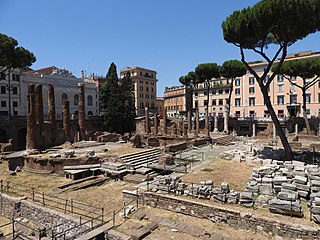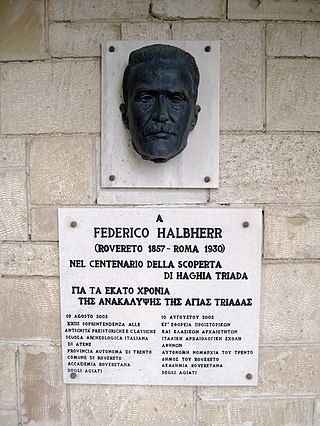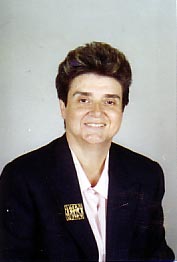Related Research Articles
Sergio Panunzio was an Italian theoretician of national syndicalism. In the 1920s, he became a major theoretician of Italian Fascism.

Largo di Torre Argentina is a large open space in Rome, Italy, with four Roman Republican temples and the remains of Pompey's Theatre. It is in the ancient Campus Martius.
Giovanni Becatti was an Italian Classical art historian and archaeologist.

Pietro Rosa was an Italian architect and topographer. He studied the settlements of the ancient Roman countryside and carried out a systematic series of excavations on the Palatine Hill in Rome.

The Meta Sudans was a large monumental conical fountain in ancient Rome.

Opus sectile is a form of pietra dura popularized in the ancient and medieval Roman world where materials were cut and inlaid into walls and floors to make a picture or pattern. Common materials were marble, mother of pearl, and glass. The materials were cut in thin pieces, polished, then trimmed further according to a chosen pattern. Unlike tessellated mosaic techniques, where the placement of very small uniformly sized pieces forms a picture, opus sectile pieces are much larger and can be shaped to define large parts of the design.
Clementina Panella is an Italian archaeologist, a professor at the University of Rome La Sapienza, where she teaches Methodology of Archaeology. She has guided and co-written a number of articles on the commercial pottery of ancient Italy.

Isola Sacra is situated in the Lazio region of Italy south of Rome, near the Tyrrhenian Sea. It is part of the town of Fiumicino.

The Italian Istituto Poligrafico e Zecca dello Stato (IPZS), founded in 1928, is situated at the via Salaria 691 in Rome. As well as producing coins, passports, and postage stamps for Italy, it serves the micro-states of the Vatican City, San Marino, and the Sovereign Military Order of Malta. It also publishes books under the imprint Libreria dello Stato. The O.C.V. and traditional productions factory, the multimedial production institute and the Mint are also located in the capital. Other factories are located in Verrès, Val d'Aosta, and Foggia, Apulia. Banknotes are produced by the Bank of Italy.

The Museo Nazionale della Magna Grecia, Museo Archeologico Nazionale di Reggio Calabria or Palazzo Piacentini is a museum in Reggio Calabria, southern Italy, housing an archaeological collection from sites in Magna Graecia.

Federico Halbherr was an Italian archaeologist and epigrapher, known for his excavations of Crete. A contemporary, good friend, and trusted advisor of Arthur Evans, he began excavating at Phaistos before Evans began excavating at Knossos. Some of his explorations were funded by the Archaeological Institute of America.
Thesaurus Florentinus is a project for the acquisition and reconstruction of the images of the mural paintings in the Cupola of Santa Maria del Fiore in Florence and a computer system to manage the hundreds of thousand pieces of information gathered during the restoration campaign ended in 1995. The project was conceived by Arch. Riccardo Dalla Negra and realised by Lapo Bertini, Silvia Brotini, Auro Pampaloni, Marco Menichetti, Lara Calosi and Arianna Sacchetti with the technological support of IBM and Eastman Kodak and the financial support of the Ministero dei Beni Culturali of Italy and Ente Cassa di Risparmio di Firenze. The project started in 1992 and ended in 2000.

Porticus Aemilia was a portico in ancient Rome. It was one of the largest commercial structures of its time and functioned as a storehouse and distribution center for goods entering the city via the Tiber river.

Anna Maria Bisi, known as A. M. Bisi, was an Italian archaeologist and academic, specialising in the Phoenicians and Punics.

Lucia Travaini is an Italian numismatist, archaeologist, and academic. She is an Associate Professor of Medieval and Modern Numismatics at the University of Milan.

Raissa Samojlovna Calza was a Ukrainian dancer who became a prominent classical archaeologist of Roman portraiture. When she was young, she fled to Italy and France following the Russian revolution.

Maria Floriani Squarciapino (1917-2003) was an Italian classical archaeologist and professor at La Sapienza University in Rome, known for her work on the Roman port city of Ostia.
Maria Giulia Amadasi Guzzo is a leading scholar in Semitic epigraphy. She is Professor of Semitic Epigraphy at the Department of Sciences of Antiquity of the Sapienza University of Rome, and the director of the "Museum of the Near East" of the University La Sapienza. She is a corresponding member of the German Archaeological Institute.
San Pier Damiani ai Monti di San Paolo is a 20th-century parochial church and titular church in the southwest suburbs of Rome, dedicated to the 11th-century saint Peter Damian.

Santa Maria Regina Pacis a Ostia Lido is a 20th-century parochial church and titular church in Ostia, southwest of Rome, dedicated to Mary, Queen of Peace.
References
 This article incorporates text from a publication now in the public domain : Smith, William, ed. (1854–1857). Dictionary of Greek and Roman Geography . London: John Murray.
This article incorporates text from a publication now in the public domain : Smith, William, ed. (1854–1857). Dictionary of Greek and Roman Geography . London: John Murray.{{cite encyclopedia}}: Missing or empty|title=(help)
- ↑ Tobias Fischer-Hansen (1990). Scavi di Ficana: Topografia generale. Istituto poligrafico e Zecca dello Stato, Libreria dello Stato. ISBN 9788824000246.
- ↑ Soprintendenza archeologica di Ostia (c. 1980). Ficana: una pietra miliare sulla strada per Roma : mostra itinerante degli scavi italo nordici a Ficana (Acilia), 1975-1980. Libreria Editrice.
- ↑ Tobias Fischer-Hansen; Italy. Soprintendenza archeologica di Ostia (1990). Scavi di Ficana: Il periodo protostorico e arcaico. pt. 1. Le zone di scavo 3b-c. Istituto poligrafico e Zecca dello Stato, Libreria dello Stato.